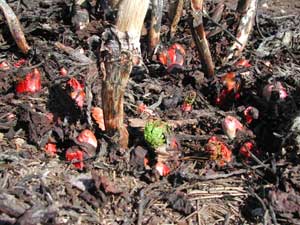 Rhubarb's
wonderful dark pink heads start emerging from the winter packed mulch as soon as
the snow recedes. It announces the promise of Spring with such beautiful design
and is watched carefully though it needs nothing from the gardener. We can taste
the first batch of rhubarb sauce long before the stalks are large enough to
harvest. Of course, you don’t have to live in snow country to appreciate
rhubarb, but it does require a cool climate to thrive, needing a cold period of
dormancy.
Rhubarb's
wonderful dark pink heads start emerging from the winter packed mulch as soon as
the snow recedes. It announces the promise of Spring with such beautiful design
and is watched carefully though it needs nothing from the gardener. We can taste
the first batch of rhubarb sauce long before the stalks are large enough to
harvest. Of course, you don’t have to live in snow country to appreciate
rhubarb, but it does require a cool climate to thrive, needing a cold period of
dormancy.
Last year I tried to hurry a plant along by putting a cold frame over it before
the snow had melted. But rhubarb is such a hardy soul that the plants outside
the cold frame kept pace with the one within -- it didn’t need such pampering.
The stalks are the edible part of the rhubarb, of course, the leaves having
poisonous levels of oxalic acid. Though classified as a vegetable or herb, I
consider it as a fruit because that’s the way I use it. It’s the only fruit that
is readily available from spring through fall, and it has to be one of the
hardiest and easiest to grow.
Though the plants, and hence your harvest, will be bigger and more lush if you
give your plants some extra care, they can also get by with minimal attention if
need be. As a child I had often enjoyed a stalk of rhubarb while playing
outside, pulled from a neglected patch of plants growing around an outbuilding.
The stalks were usually thin, but I don’t recall wanting anything larger.
You can buy rhubarb roots, but it’s usually easy to get a chunk of root and
crown from anyone with plants, just ask around. We got our first roots when we
bought a used tractor from a couple who had just dug up a long row of rhubarb,
wanting to get rid of it. After chaining the tractor on the trailer for its trip
to our place, they happily added several bushels of roots. And, of course, we
planted them all. As we didn’t have a place in our new garden, we dug them into
the field sod along the fence, in the middle of summer. In spite of such poor
treatment and soil, they grew and gave us many years of harvest -- much more
than we could use. Rhubarb seed doesn’t come true to type, and in my experiments
is not very viable, so it is almost always propagated by dividing the root ball.
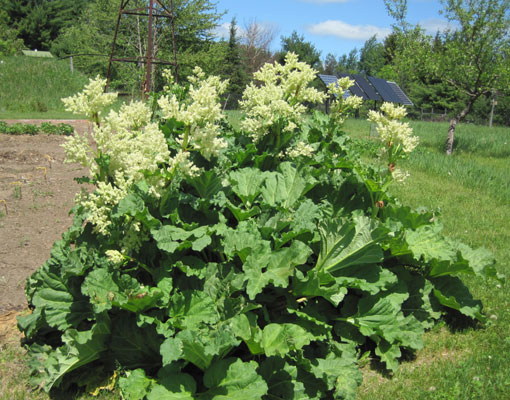 When we moved our garden, I transplanted five plants into an old garden bed. The
rhubarb responded to this kindness by producing large harvests of thick, juicy
stalks -- more than the 25 plants had before. It’s amazing what a little good
soil can do. Feed your soil, and the plants will feed you.
When we moved our garden, I transplanted five plants into an old garden bed. The
rhubarb responded to this kindness by producing large harvests of thick, juicy
stalks -- more than the 25 plants had before. It’s amazing what a little good
soil can do. Feed your soil, and the plants will feed you.
Occasionally I spread a little compost on the plot in the late fall, if I have
extra, and once in a while a few forkfulls of mulch, but mostly the rhubarb
takes care of itself. The five plant patch has thrived for almost 20 years and
is still going strong, though it is now a separate island in the grass. A few
times I dug out a shovel-full of root when I noticed the stalks getting thinner
and crowded-thick, filling the space with compost and garden soil. We’ve eaten
many meals from this small plot.
One of my favorite attributes of the rhubarb plant is that it doesn’t need
weeding. How can you not like a plant like that! The large, spreading leaves are
self-mulching -- while growing and as they die. When I harvest the stalks, I
break off the leaves and tuck them under the plant. Occasionally a stubborn
perennial weed might get a toe-hold, but if the rhubarb is planted about three
feet apart, it will form a nice thick mulched area. It certainly doesn’t hurt,
however, to give it a little help by adding some additional mulch.
The mulching aspect of rhubarb makes it great as a barrier plant. For years my
plants easily kept the grass out of the compost bins, which were along one
corner edge of our permanent bed garden, between the garden and the field. The
rhubarb was planted along the outer side of the bins. We simply mowed along
their outer edge and they kept the field from encroaching into the compost bins
and garden. The rest of the perimeter between field and garden needed to be kept
tilled or hoed to keep the grass back.
A major garden renovation a few years ago (making it wonderfully smaller) ended
with a long expanded plot of rhubarb and asparagus along the entire east side of
the garden. I simply dug and transplanted large shovel fulls of rhubarb root
into its new bed in late fall, mulching it well with hay. By the next fall it
was well established, productive, and self mulching. If you plant small root
pieces, you’ll need to wait until the plant is producing good, strong, large
stems before harvesting much, to give it a chance to get well established.
Though rhubarb is often thought of as a spring crop, and maybe most appreciated
then, we harvest and use it through the summer as well. It’s our main “fruit”
source between the last of the dried apples in the spring and the first of the
fresh apples in late summer, supplemented with the various berries as they
arrive. In mid-summer when the rhubarb stalks start getting spongy and the
leaves yellowing, I go through and pull off all the older, past-prime, yellowing
stalks, leaving the fresh, younger stalks and leaves. This seems to re-vigorate
the plants and they produce a second flush of harvestable stems. You don’t want
to harvest all of the stalks at any time, of course -- the plant needs a supply
of leaves to feed its roots. I harvest thumb size and larger stalks, leaving the
smaller ones to supply the plant. If you pay attention to your plants, you’ll
know if you’re taking too much. But it’s a very generous soul, so with just a
little extra care, you’ll have a good harvest.
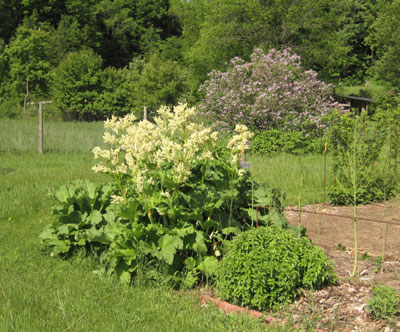 FLOWERS
-- An often overlooked aspect of rhubarb is its flowers. Many people pull those
stalks off as soon as they appear but I let ours go. We have plenty of rhubarb
growing but I haven't noticed the flowers affecting the harvest anyway. And they
are lovely flowers on those sturdy robust stalks. Not for the timid is rhubarb,
even when flowering. But the main reason I let them go
FLOWERS
-- An often overlooked aspect of rhubarb is its flowers. Many people pull those
stalks off as soon as they appear but I let ours go. We have plenty of rhubarb
growing but I haven't noticed the flowers affecting the harvest anyway. And they
are lovely flowers on those sturdy robust stalks. Not for the timid is rhubarb,
even when flowering. But the main reason I let them go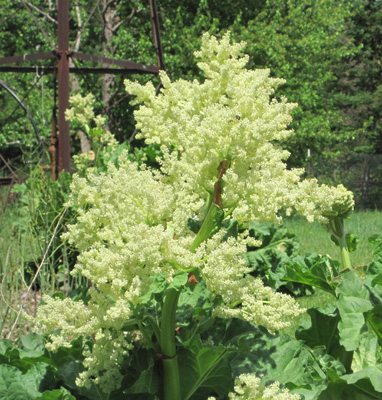 is for the pollinators - they LOVE the flowers, especially appreciated at this
time of year when most of the trees are through flowering and summer flowers are
still waiting for warmer weather. It doesn't show in the photo but that cloud of
white bloom is buzzing with all manner of buzzer types.
It’s generally advised to keep the flower stalks picked (which can be a job in
itself with a good and healthy patch!) bit I think it’s worth the possibility of maybe shorting my own harvest
a bit to add to theirs. Plus they are attractive. I cut the flower stalks when the bloom is done and seed forming. The plant is thankfully quite hardy and seldom bothered with insect pests or
diseases.
is for the pollinators - they LOVE the flowers, especially appreciated at this
time of year when most of the trees are through flowering and summer flowers are
still waiting for warmer weather. It doesn't show in the photo but that cloud of
white bloom is buzzing with all manner of buzzer types.
It’s generally advised to keep the flower stalks picked (which can be a job in
itself with a good and healthy patch!) bit I think it’s worth the possibility of maybe shorting my own harvest
a bit to add to theirs. Plus they are attractive. I cut the flower stalks when the bloom is done and seed forming. The plant is thankfully quite hardy and seldom bothered with insect pests or
diseases.
SAUCE -- We love that lively flavor in the spring when fresh rhubarb sauce is
mixed with our canned apple sauce. It never lets us down.
Rhubarb sauce is easy. Cut up a supply of stalks, add a little water and
sweetening, and simmer until soft. Now the downside of
rhubarb is that it does take a fair amount of sweetening to be comfortably
palatable. Our favorite is maple syrup, but mostly I use honey and brown sugar.
When other fruits start bearing the rhubarb mixed in helps extend those harvests
and adds a great deal of flavor, especially to a mild fruit like blueberries.
But strawberry-rhubarb sauce is probably our favorite.
The sauce can be used in many ways, eaten for itself or as part of another dish,
as desert, simply or elegantly complicated, dolloped on pancakes. We use it most often, alone or mixed
with other fruit, with raw or cooked rolled oats (and sunflower seeds, raisins, nuts)
for our breakfast meal. It's also good over fresh baked whole grain biscuits! Or
mixed with yoghurt.
A palatable rhubarb wine can be made, as well as a delicious jam. You can freeze it or can it.
Drying is possible though I
wouldn't recommend that (all you get are hard little sour pieces that
reconstitute into mushy little sour pieces with little flavor). But it doesn’t
need such extra work anyway as it is so easily available fresh for such a long
stretch. It can’t be beat as a quick and lively pick-me-up when eaten raw right
in the garden -- quenching many thirsts and custom made for summer
working-in-the-garden snacks.
* * * * * *
Copyright
© 2004-2018 by Susan Robishaw
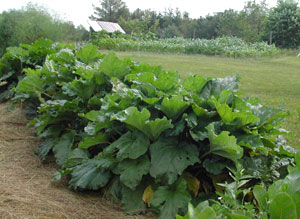



 Rhubarb's
wonderful dark pink heads start emerging from the winter packed mulch as soon as
the snow recedes. It announces the promise of Spring with such beautiful design
and is watched carefully though it needs nothing from the gardener. We can taste
the first batch of rhubarb sauce long before the stalks are large enough to
harvest. Of course, you don’t have to live in snow country to appreciate
rhubarb, but it does require a cool climate to thrive, needing a cold period of
dormancy.
Rhubarb's
wonderful dark pink heads start emerging from the winter packed mulch as soon as
the snow recedes. It announces the promise of Spring with such beautiful design
and is watched carefully though it needs nothing from the gardener. We can taste
the first batch of rhubarb sauce long before the stalks are large enough to
harvest. Of course, you don’t have to live in snow country to appreciate
rhubarb, but it does require a cool climate to thrive, needing a cold period of
dormancy. When we moved our garden, I transplanted five plants into an old garden bed. The
rhubarb responded to this kindness by producing large harvests of thick, juicy
stalks -- more than the 25 plants had before. It’s amazing what a little good
soil can do. Feed your soil, and the plants will feed you.
When we moved our garden, I transplanted five plants into an old garden bed. The
rhubarb responded to this kindness by producing large harvests of thick, juicy
stalks -- more than the 25 plants had before. It’s amazing what a little good
soil can do. Feed your soil, and the plants will feed you.  FLOWERS
-- An often overlooked aspect of rhubarb is its flowers. Many people pull those
stalks off as soon as they appear but I let ours go. We have plenty of rhubarb
growing but I haven't noticed the flowers affecting the harvest anyway. And they
are lovely flowers on those sturdy robust stalks. Not for the timid is rhubarb,
even when flowering. But the main reason I let them go
FLOWERS
-- An often overlooked aspect of rhubarb is its flowers. Many people pull those
stalks off as soon as they appear but I let ours go. We have plenty of rhubarb
growing but I haven't noticed the flowers affecting the harvest anyway. And they
are lovely flowers on those sturdy robust stalks. Not for the timid is rhubarb,
even when flowering. But the main reason I let them go is for the pollinators - they LOVE the flowers, especially appreciated at this
time of year when most of the trees are through flowering and summer flowers are
still waiting for warmer weather. It doesn't show in the photo but that cloud of
white bloom is buzzing with all manner of buzzer types.
It’s generally advised to keep the flower stalks picked (which can be a job in
itself with a good and healthy patch!) bit I think it’s worth the possibility of maybe shorting my own harvest
a bit to add to theirs. Plus they are attractive. I cut the flower stalks when the bloom is done and seed forming. The plant is thankfully quite hardy and seldom bothered with insect pests or
diseases.
is for the pollinators - they LOVE the flowers, especially appreciated at this
time of year when most of the trees are through flowering and summer flowers are
still waiting for warmer weather. It doesn't show in the photo but that cloud of
white bloom is buzzing with all manner of buzzer types.
It’s generally advised to keep the flower stalks picked (which can be a job in
itself with a good and healthy patch!) bit I think it’s worth the possibility of maybe shorting my own harvest
a bit to add to theirs. Plus they are attractive. I cut the flower stalks when the bloom is done and seed forming. The plant is thankfully quite hardy and seldom bothered with insect pests or
diseases.